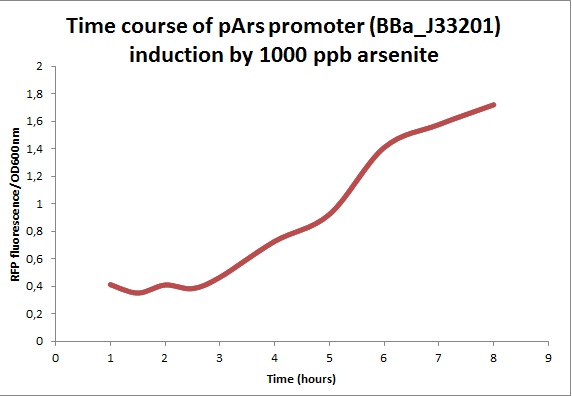Team:Buenos Aires/ model
From 2013.igem.org
(→Arsenic promoter + ArsR + Reporter) |
(→Deterministic Model) |
||
| Line 25: | Line 25: | ||
Nothing else to do but to come up with a different idea for the design. Note that the model of the Pars promoter + ArsR is still usefull because is the main block of any design to detect Arsenic in water. For details on how we model this click here. | Nothing else to do but to come up with a different idea for the design. Note that the model of the Pars promoter + ArsR is still usefull because is the main block of any design to detect Arsenic in water. For details on how we model this click here. | ||
| + | |||
| + | ===Toggle Switch + Quorum Sensing + Reporter=== | ||
| + | |||
| + | Our second design was based on the work done by the [https://2011.igem.org/Team:Grenoble Grenoble Team 2010]. They coupled a toggle switch with a quorum sensing circuit to produce a system that produces a coloured pigment if and only if a specific IPTG/Hg concentration ratio co-exist in the water. IPTG concentrations are determined previously so as to activate the system at a desired Hg concentration. | ||
| + | |||
| + | Two main problems arise from the mathematical analysis of this system: | ||
| + | |||
| + | * | ||
| + | |||
| + | * | ||
Revision as of 15:24, 26 September 2013
Contents |
Deterministic Model
Introduction
Our objective was to assemble a system that could respond to different concentrations of a specific contaminant in water. More specifically, the idea was to produce different amounts of a coloured pigment depending on the concentration of the contaminant present in water.
We worked with Arsenic knowing that an arsenic detoxification operon (Ars operon) exist in nature and more important, it exists as a biobricks.
Got Ideas?
For our biosensor we came up with three different designs each one motivated on improving the flaws detected while analysing the previous ones using mathematical models as our main tools. We describe briefly the first two designs, which were rejected, to emphasize the importance of mathematical model to gain insight on how our system works and as a feasibility study taking into considerations .
Arsenic promoter + ArsR + Reporter
First we tried to keep it as simple as we could. Figure 1 shows our first design which, in theory, produces different responses to different concentrations of arsenic in water. Figure 2 shows a simulation graphing the time series response of the Pars promoter-arsR for different concentrations of ars.
Althought we have a system that recognise and respond differently to different concentrations of arsenic since our reporter was meant to be a coloured pigment (the reasons for this are detailed in the project tab) scale tuning needs to be taken into account.The reporter is downstream the Pars promoter and the design shows little flexibility, i.e. few available parameters, to produce a discernable coloured output.
Another problem is that we aimed to use a reporter (unknown at that time) with a low degradation rate thus if the production of the pigment didn't stop at some point, accumulation of the pigment leading to eye saturation would become a problem. Although the model shows a steady state (figure 2) this accounts only for one bacteria with the degradation/dilution rate governed mainly by dilution.
Nothing else to do but to come up with a different idea for the design. Note that the model of the Pars promoter + ArsR is still usefull because is the main block of any design to detect Arsenic in water. For details on how we model this click here.
Toggle Switch + Quorum Sensing + Reporter
Our second design was based on the work done by the Grenoble Team 2010. They coupled a toggle switch with a quorum sensing circuit to produce a system that produces a coloured pigment if and only if a specific IPTG/Hg concentration ratio co-exist in the water. IPTG concentrations are determined previously so as to activate the system at a desired Hg concentration.
Two main problems arise from the mathematical analysis of this system:
Unfortunately
As it is shown in the figure below, in the presence of arsenite (1000 ppb) a typical transcriptional induction is observed over time. There is a lag of 3 hours in the mRFP produciton after adding arsenite.
 "
"
